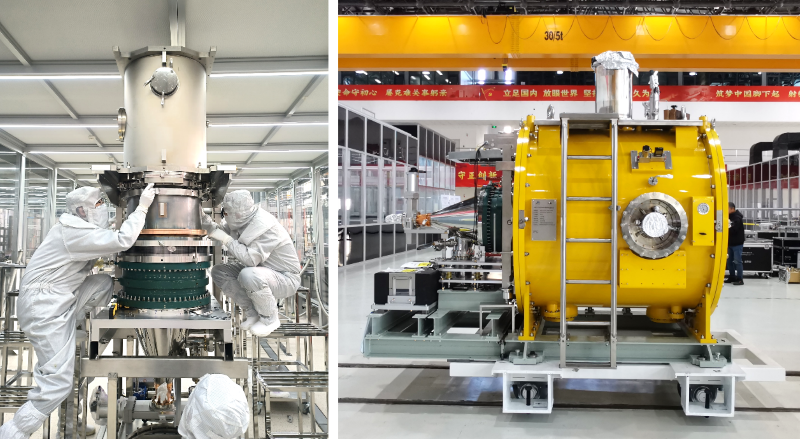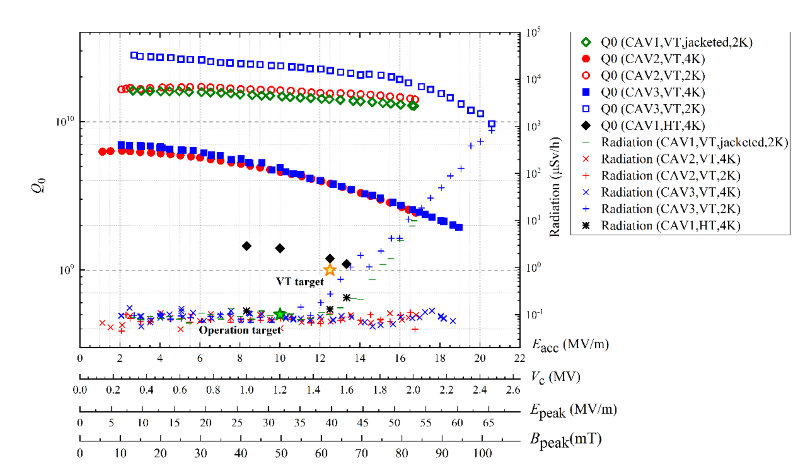The 166 MHz cryomodule is used to accelerate the electron beam and is a key piece of equipment on the HEPS storage ring. The 166 MHz superconducting cavity, high-power coupler, higher-order-mode absorber, tuner, beamline components of the cavity string, and cryostat have been developed in-house by the HEPS Radio Frequency (RF) team led by Dr. Pei Zhang and Cryogenics team led by Dr. Rui Ge.
The 166 MHz superconducting cavity, high-power coupler, and cavity string components were manufactured by Beijing HE-Racing Technology Co., Ltd., and the cryostat was manufactured by Hefei Juneng Electro Physics High-tech Development Co., Ltd. The design, post-processing, system integration, and high-power tests of the cryomodule were conducted by physicists and engineers of the HEPS RF and Cryogenics teams. Strong support has been received from the Platform of Advanced Photon Source Technology R&D (PAPS).
At 4 K, when the accelerating voltage reached the HEPS operating goal of 1.2 MV, the quality factor of the 166 MHz cryomodule reached 1.4E+9, and the dynamic heat load of the module was measured to be 7.4 W, with no field emission observed. At an acceleration voltage of 1.6 MV, the quality factor of the module reached 1.1E+9. When the peak electric field inside the cavity reached 42.7 MV/m, the field-emission-induced radiation was measured to be less than 0.3 μSv/h, equivalent to the bare cavities during vertical tests. In addition, the measurements of the higher order modes are consistent with the simulation predictions, meeting the requirements of HEPS. The cryomodule was stably operated at 1.2 MV for six days.
The 166 MHz cavity is the world’s first quarter-wave SRF structure to accelerate relativistic particles (beta=1) as a main accelerating cavity, and it has achieved heavy damping of higher order modes. Building on the successful development of the bare cavities in 2022, Dr. Pei Zhang’s team has developed a series of key components, including the 166 MHz jacketed cavity, the 166 MHz 250 kW continuous-wave high-power coupler, and a 10 kW high order mode ferrite absorber with a diameter of 505 mm. Simultaneously, in collaboration with the engineering staff from Beijing HE-Racing Technology Co., Ltd., a series of technical obstacles were overcome in the cleaning of large-size ferrite absorbers to achieve particle-free and clean assembly of the cavity string, achieving field-emission-free operation of the cryomodule at the design voltage, comparable to the radiation level during the vertical tests. The 166 MHz cavity string has large dimensions, a heavy weight, and high tuning stiffness, thus posing significant challenges for the cryostat design. Dr. Rui Ge’s team has overcome a series of challenges, such as integrating the cavity string with the cryostat, through continuous technical breakthroughs, and successfully developed the 166 MHz cryostat and the horizontal test station.
Series production of the 166 MHz superconducting cavities and cryostats has been launched, and cryomodule assembly will be in full swing in 2024, in preparation for the subsequent installation and commissioning of the HEPS storage ring.

166 MHz cavity string clean assembly (left) and cryomodule (right)

166 MHz horizontal test results
